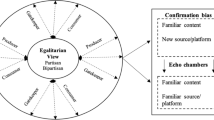Abstract
Attempts to explain the emergence of policy innovation are regularly constrained by the complexities of political processes and the vagaries of social circumstance. Content analysis of media reports has been used routinely to provide an outline of policy change. However, the results of content analysis can be simplistic and lacking in depth of meaning. This study added the use of principal components analysis (PCA) of media text content to more substantively examine the evolution of a policy “sea-change.” Both the manifest and latent content of newspaper accounts were analyzed to measure the salience of a public policy innovation that expanded religious group utilization with the 1996 welfare reform act. In addition to tracing variations in the flow of policy deliberation, the analysis more fully captured the character of public discourse that surrounded the adoption of this controversial policy. Unexpected findings from analysis of the accounts included limited concern for Constitutional infringement and no evidence of a regional bias toward increased religious group utilization. Furthermore, principal components analysis of textual structure exhibited patterns of discourse indicative of privatistic (rather than communal) religious response, limited concern with diverse social groups and pronounced reliance on “praise and blame” persuasive strategies.
Similar content being viewed by others
References
Baumgartner, F. R. and B. D. Jones (1993). Agendas and Instability in American Politics. Chicago, IL: The University of Chicago Press.
deLeon, P. (1997). Democracy and the Policy Sciences. Albany, NY: State University of New York Press.
Dery, D. (1984). Problem Definition in Policy Analysis. Lawrence, KS: University Press of Kansas.
deLeon, P. (1988). The contextual burdens of policy design. Policy Studies Journal, 17(2), 297-309.
Donati, P. R. (1992). ‘Political discourse analysis’, in M. Diani and R. Eyerman, eds., Studying Collective Action. London: Sage Publications, pp. 136 – 167.
Dryzek, J. S. (1990). Discursive Democracy: Politics, Policy, and Political Science. New York: Cambridge University Press.
Elazar, D. J. (1994). The American Mosaic: The Impact of Space, time, and Culture on American Politics. Boulder: Westview.
Forester, J. (1994). ‘Political judgement and learning about value in transportation planning: Bridging Habermas and Aristotle,’ In H. Thomas ed., Values and Planning. Brookfield, VT: Ashgate Pub. Co., pp. 231.
Frame, R. (1995). ‘Religious nonprofits fight for government funds,’ Christianity Today 38: 65.
Garson, G. D. (1998). ‘Statnotes: An online textbook,’ Retrieved 4/12/99, 1999, from http://www2.chass. ncsu.edu/garson/ pa765/statnote.htm
Gillmor, D. M., J. A. Barron, T. F. Simon, and H. A. Terry (1990). Mass Communication Law: Cases and Comment (5th ed.). St. Paul, MN: West Publishing Company.
Guralnik, D. B. (ed.). (1970). Webster's New World Dictionary of the American Language (Second College ed.). New York: The World Publishing Company.
Hajer, M. A. (1993). ‘Discourse coalitions and the institutionalization of practice: The case of acid rain in Britain’, in F. Fischer and J. Forester, eds., The Argumentative Turn in Policy Analysis and Planning. Durham, North Carolina: Duke University Press, pp. 42 – 76.
Hart, R. P. (2000). Diction: User's manual (Version 5.0). Austin, TX: Digitext, Inc.
Houghton, D. P. (1998). ‘Analogical reasoning and policymaking: Where and when is it used’? Policy Sciences 31: 151 – 176.
Kingdon, J. W. (1995). Agendas, Alternatives, and Public Policies (2nd ed.). New York, NY: HarperCollins College Publishers.
Leach, J. (2000). ‘Rhetorical analysis’, in M. W. Bauer and G. Gaskell, eds., Qualitative Researching with Text, Image, and Sound. London: Sage Publications, pp. 207 – 226.
Majone, G. (1989). Evidence, Argument, and Persuasion in the Policy Process. New Haven, CT: Yale University Press.
Milbank, D. (1995). ‘Republicans split on the role of government in aiding poor after social programs are cut,’ Wall Street Journal A12.
Mucciaroni, G. (1994). ‘Problem period definition and special interest politics in tax policy and agriculture’, in D. A. Rochefort and R. W. Cobb, eds., The Politics of Problem Definition Lawrence. KS: University Press of Kansas, pp. 117 – 137.
Polsby, N. W. (1984). Political Innovation in America: The Politics of Policy Initiation. New Haven, CT: Yale University Press.
Rees, S. (1999). ‘Strategic choices for nonprofit advocates,’ Nonprofit and Voluntary Sector Quarterly 28(1): 65 – 73.
Riggins, S. H. (1997). ‘The rhetoric of Othering’, in S. H. Riggins, ed., The Language and Politics of Exclusion: Others in Discourse. Thousand Oaks: Sage Publications, pp. 1 – 30.
Rochefort, D. A. and R. W. Cobb (eds.). (1994). The Politics of Problem Definition: Shaping the Policy Agenda. Lawrence, KS: University Press of Kansas.
Sabatier, P. A. and H. C. Jenkins-Smith (eds.). (1993). Policy Change and Learning: An Advocacy Coalition Approach. Boulder, CO: Westview Press.
Schneider, A. L. and H. Ingram (1997). Policy Design for Democracy. Lawrence, KS: University Press of Kansas.
Schon, D. and M. Rein (1994). Frame Reflection: Toward the Resolution of Intractable Policy Controversies. New York: Basic Books.
Schram, S. F. (1995). Words of Welfare: The Poverty of Social Science and the Social Science of Poverty. Minneapolis: University of Minnesota Press.
Sharma, S. (1996). Applied Multivariate Techniques. New York: John Wiley and Sons, Inc.
Stone, D. (2002). Policy Paradox: The Art of Political Decision Making (Revised ed.). New York: W. W. Norton and Co.
Van Dijk, T. A. (1997). ‘The study of discourse,’ in T. A. Van Dijk, ed., Discourse as Structure and Practice period London: Sage Publications, pp. 1 – 34.
Whiteley, P. F. and S. J. Winyard (1987). Pressure for the Poor: The Poverty Lobby and Policy Making. London: Methuen.
Wildavsky, A. (1979). Speaking Truth to Power. Boston, MA: Little-Brown.
Wimmer, R. D. and J. R. Dominick (1991). Mass Media Research: An Introduction (3rd ed.). Belmont, CA: Wadsworth Publishing Company.
Wolpert, J. (1993). Patterns of Generosity in America: Who's Holding the Safety Net? New York: The Twentieth Century Fund Press.
Author information
Authors and Affiliations
Corresponding author
Rights and permissions
About this article
Cite this article
Kinney, N.T. Engaging in ‘Loose Talk’: Analyzing Salience in Discourse from the Formulation of Welfare Policy. Policy Sci 38, 251–268 (2005). https://doi.org/10.1007/s11077-006-9009-4
Received:
Accepted:
Published:
Issue Date:
DOI: https://doi.org/10.1007/s11077-006-9009-4




